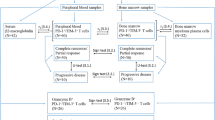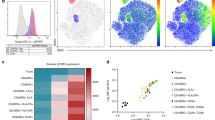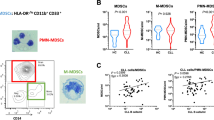Abstract
Immune mechanisms have been shown to contribute to the process of myelodysplastic syndromes (MDS)-related bone marrow (BM) failure. The aim of this study was to evaluate the possible contribution of activated monocytes through CD40–CD40L(CD154) interactions with activated T helper cells. We demonstrated in 77 predominantly lower risk MDS patients that the CD40 receptor was expressed significantly higher on monocytes and that CD40L was expressed significantly higher on T helper cells in peripheral blood (PB) and BM. Increased levels of CD40 and CD40L were detected in the same patients. In addition, stimulation of the CD40 receptor on purified PB monocytes led to a significantly higher tumor necrosis factor alpha production in patients. Co-culture of BM mononuclear cells of 21 patients in the presence of a blocking CD40 monoclonal antibody (ch5D12) led to a significant increase in the number of colony-forming units. A correlation was seen between increased CD40 expression on monocytes with patients’ age below 60 years and with the cytogenetic abnormality trisomy 8. These results demonstrate that CD40 expression on monocytes may identify a subgroup of MDS patients in whom immune-mediated hematopoietic failure is part of the disease process. As such, the CD40–CD40L-based activation of monocytes might be a target to counteract MDS-related BM failure.
This is a preview of subscription content, access via your institution
Access options
Subscribe to this journal
Receive 12 print issues and online access
$259.00 per year
only $21.58 per issue
Buy this article
- Purchase on Springer Link
- Instant access to full article PDF
Prices may be subject to local taxes which are calculated during checkout





Similar content being viewed by others
References
Delforge M . Understanding the pathogenesis of myelodysplastic syndromes. Hematol J 2003; 4: 303–309.
Molldrem JJ, Jiang YZ, Stetler-Stevenson M, Mavroudis D, Hensel N, Barrett AJ . Haematological response of patients with myelodysplastic syndrome to antithymocyte globulin is associated with a loss of lymphocyte-mediated inhibition of CFU-GM and alterations in T-cell receptor Vbeta profiles. Br J Haematol 1998; 102: 1314–1322.
Baumann I, Scheid C, Koref MS, Swindell R, Stern P, Testa NG . Autologous lymphocytes inhibit hemopoiesis in long-term cultures in patients with myelodysplastic syndromes. Exp Hematol 2002; 30: 1405–1411.
Epperson DE, Nakamura R, Saunthararajah Y, Melenhorst JJ, Barrett AJ . Oligoclonal T cell expansion in myelodysplastic syndrome: evidence for an autoimmune process. Leuk Res 2001; 25: 1075–1083.
Sloand EM, Mainwaring L, Fuhrer M, Ramkissoon S, Risitano AM, Keyvanafar K et al. Preferential suppression of trisomy 8 compared with normal hematopoietic cell growth by autologous lymphocytes in patients with trisomy 8 myelodysplastic syndrome. Blood 2005; 106: 841–851.
Wlodarski MW, Gondek LP, Nearman ZP, Plasilova M, Kalaycio M, Hsi ED et al. Molecular strategies for detection and quantitation of clonal cytotoxic T-cell responses in aplastic anemia and myelodysplastic syndrome. Blood 2006; 108: 2632–2641.
Epling-Burnette PK, Painter JS, Rollison DE, Ku E, Vendron D, Widen R et al. Prevalence and clinical association of clonal T-cell expansions in Myelodysplastic Syndrome. Leukemia 2007; 21: 659–667.
Jonasova A, Neuwirtova R, Cermak J . Cyclosporin A therapy in hypoplastic MDS patients and certain refractory anaemias without hypoplastic bone marrow. Br J Haematol 1998; 200: 304–309.
Tichelli A, Gratwohl A, Wuersch A, Nissen C, Speck B . Antilymphocyte globulin formyelodysplastic syndrome? Br J Haematol 1988; 68: 139–140.
Biesma D, van den Tweel J, Verdonck L . Immunosuppressive therapy for hypoplastic myelodysplastic syndrome. Cancer 1997; 79: 1548–1551.
Molldrem J, Caples M, Mavroudis D, Plante M, Young NS, Barrett AJ . Antithymocyte globulin (ATG) abrogates cytopenias in patients with myelodysplastic syndrome. Br J Haematol 1997; 99: 699–705.
Molldrem J, Rivera M, Bahceci E . Treatment of bone marrow failure of myelodysplastic syndrome with antithymocyte globulin. Ann Intern Med 2002; 137: 156–163.
Broliden PA, Dahl IM, Hast R, Johansson B, Juvonen E, Kjeldsen L et al. Antithymocyte globulin and cyclosporine A as combination therapy for low-risk non-sideroblastic myelodysplastic syndromes. Haematologica 2006; 91: 667–670.
Barrett J, Sloand E, Young N . Determining which patients with myelodysplastic syndrome will respond to immunosuppressive treatment. Haematologica 2006; 91: 583–584.
Kitagawa M, Saito I, Kuwata T, Yoshida S, Yamaguchi S, Takahashi M et al. Overexpression of tumor necrosis factor (TNF)-alpha and interferon (IFN)-gamma by bone marrow cells from patients with myelodysplastic syndromes. Leukemia 1997; 11: 2049–2054.
Parker J, Mufti G . The myelodysplastic syndromes: a matter of life or death. Acta Haematologica 2004; 111: 78–99.
Visani G, Zauli G, Tosi P, Fogli M, Cenacchi A, Finelli C et al. Impairment of GM-CSF production in myelodysplastic syndromes. Br J Haematol 1993; 84: 227–231.
Grewal IS, Flavell RA . CD40 and CD154 in cell-mediated immunity. Annu Rev Immunol 1998; 16: 111–135.
van Kooten C, Banchereau J . CD40-CD40 ligand. J Leukoc Biol 2000; 67: 2–17.
Harigai M, Hara M, Nakazawa S, Fukasawa C, Ohta S, Sugiura T et al. Ligation of CD40 induced tumor necrosis factor-alpha in rheumatoid arthritis: a novel mechanism of activation of synoviocytes. J Rheumatol 1999; 26: 1035–1043.
Sekine C, Yagita H, Miyasaka N, Okumura K . Expression and function of CD40 in rheumatoid arthritis synovium. J Rheumatol 1998; 25: 1048–1053.
Kasran A, Boon L, Wortel CH, Hogezand RA, Schreiber S, Goldin E et al. Safety and tolerability of antagonist anti-human CD40 Mab ch5D12 in patients with moderate to severe Crohn's disease. Aliment Pharmacol Ther 2005; 22: 111–122.
Carlsen HS, Yamanaka T, Scott H, Rugtveit J, Brandtzaeg P . The proportion of CD40+ mucosal macrophages is increased in inflammatory bowel disease whereas CD40 ligand (CD154)+ T cells are relatively decreased, suggesting differential modulation of these costimulatory molecules in human gut lamina propria. Inflamm Bowel Dis 2006; 12: 1013–1024.
t Hart BA, Blezer EL, Brok HP, Boon L, de Boer M, Bauer J et al. Treatment with chimeric anti-human CD40 antibody suppresses MRI-detectable inflammation and enlargement of pre-existing brain lesions in common marmosets affected by MOG-induced EAE. J Neuroimmunol 2005; 163: 31–39.
Carayanniotis G, Masters SR, Noelle RJ . Suppression of murine thyroiditis via blockade of the CD40–CD40L interaction. Immunology 1997; 90: 421–426.
Companjen AR, van der Wel LI, Boon L, Prens EP, Laman JD . CD40 ligation-induced cytokine production in human skin explants is partly mediated via IL-1. Int Immunol 2002; 14: 669–676.
Benveniste EN, Nguyen VT, Wesemann DR . Molecular regulation of CD40 gene expression in macrophages and microglia. Brain Behav Immun 2004; 18: 7–12.
Maciejewski J, Selleri C, Anderson S, Young NS . Fas antigen expression on CD34+ human marrow cells is induced by interferon gamma and tumor necrosis factor alpha and potentiates cytokine-mediated hematopoietic suppression in vitro. Blood 1995; 85: 3183–3190.
Eisen HN . Specificity and degeneracy in antigen recognition: yin and yang in the immune system. Annu Rev Immunol 2001; 19: 1–21.
Burger D, Molnarfi N, Gruaz L, Dayer JM . Differential induction of IL-1beta and TNF by CD40 ligand or cellular contact with stimulated T cells depends on the maturation stage of human monocytes. J Immunol 2004; 173: 1292–1297.
Kook H, Zeng W, Guibin C, Kirby M, Young NS, Maciejewski JP . Increased cytotoxic T cells with effector phenotype in aplastic anemia and myelodysplasia. Exp Hematol 2001; 29: 1270–1277.
Sugimoto K, Galle C, Preiser JC, Creteur J, Vincent JL, Pradier O . Monocyte CD40 expression in severe sepsis. Shock 2003; 19: 24–27.
Saunthararajah Y, Nakamura R, Wesley R, Wang QJ, Barrett AJ . A simple method to predict response to immunosuppressive therapy in patients with myelodysplastic syndrome. Blood 2003; 102: 3025–3027.
Tai YT, Catley LP, Mitsiades CS, Burger R, Podar K, Shringpaure R et al. Mechanisms by which SGN-40, a humanized anti-CD40 antibody, induces cytotoxicity in human multiple myeloma cells: clinical implications. Cancer Res 2004; 64: 2846–2852.
Tai Y-T, Li X-F, Catley L, Coffey R, Breitkreutz I, Bae J et al. Immunomodulatory drug lenalidomide (CC-5013, IMiD3) augments anti-CD40 SGN-40-induced cytotoxicity in human multiple myeloma: clinical Implications. Cancer Res 2005; 65: 11712–11720.
Fanale MA, Younes A . Monoclonal antibodies in the treatment of non-Hodgkin's lymphoma. Drugs 2007; 67: 333–350.
Hayashi T, Treon SP, Hideshima T, Tai YT, Akiyama M, Richardson P et al. Recombinant humanized anti-CD40 monoclonal antibody triggers autologous antibody-dependent cell-mediated cytotoxicity against multiple myeloma cells. Br J Haematol 2003; 121: 592–596.
Lum HD, Buhtoiarov IN, Schmidt BE, Berke G, Paulnock DM, Sondel PM et al. Tumoristatic effects of anti-CD40 mAb-activated macrophages involve nitric oxide and tumour necrosis factor-alpha. Immunology 2006; 118: 261–270.
Acknowledgements
SM, CV and MD are supported by research fundings from the Research Foundation-Flanders (FWO). SM is a research fellow and MD is a clinical professor of the FWO. LB contributed vital new reagents (clone 64 and ch5D12) to perform this research.
Author information
Authors and Affiliations
Corresponding author
Rights and permissions
About this article
Cite this article
Meers, S., Kasran, A., Boon, L. et al. Monocytes are activated in patients with myelodysplastic syndromes and can contribute to bone marrow failure through CD40–CD40L interactions with T helper cells. Leukemia 21, 2411–2419 (2007). https://doi.org/10.1038/sj.leu.2404940
Received:
Revised:
Accepted:
Published:
Issue Date:
DOI: https://doi.org/10.1038/sj.leu.2404940
Keywords
This article is cited by
-
Myelodysplastic syndromes
Nature Reviews Disease Primers (2022)
-
Autologous bone marrow Th cells can support multiple myeloma cell proliferation in vitro and in xenografted mice
Leukemia (2017)



